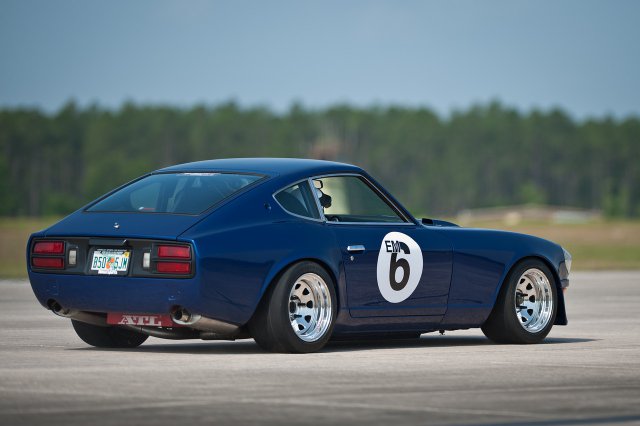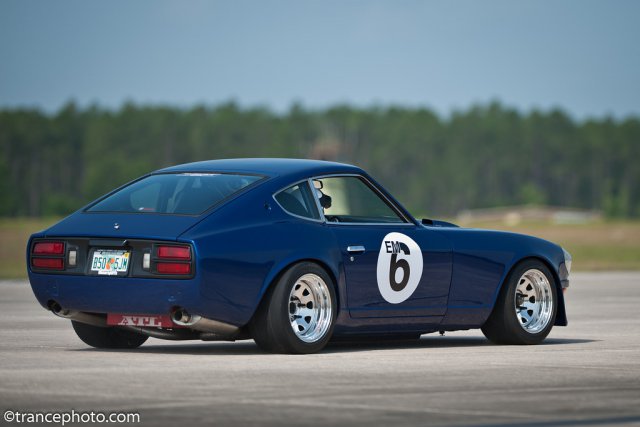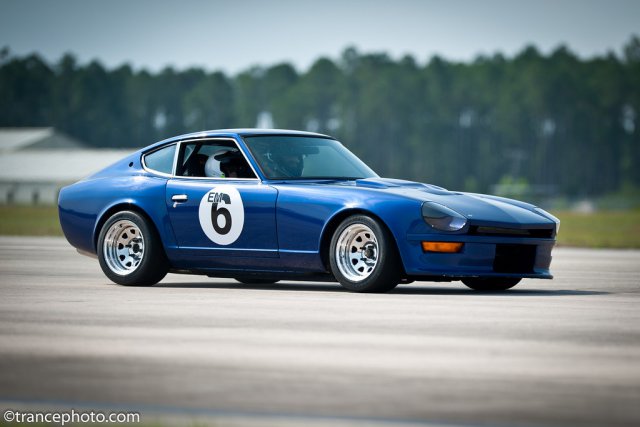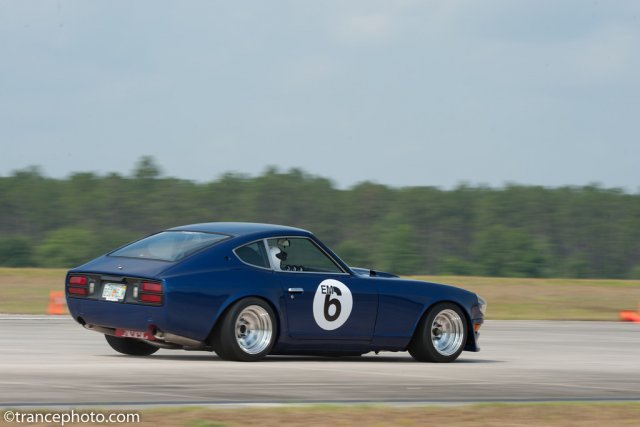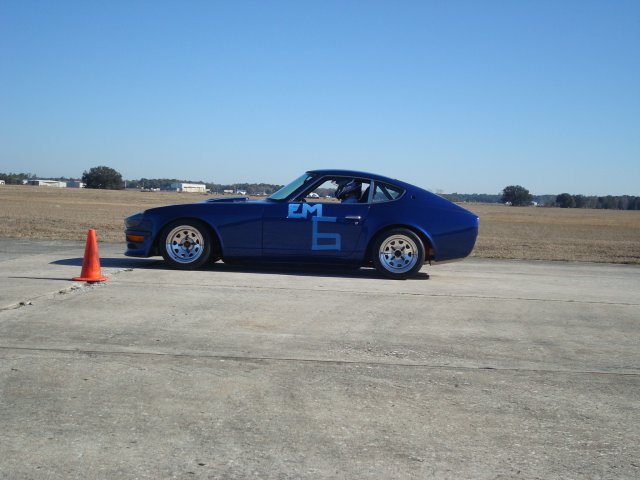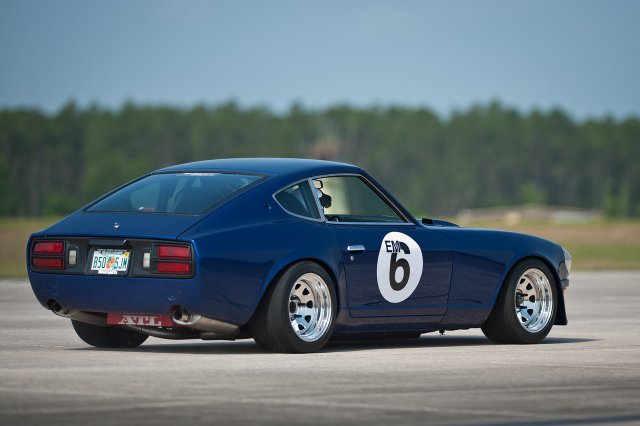-
Posts
1193 -
Joined
-
Last visited
-
Days Won
30
Content Type
Profiles
Forums
Blogs
Events
Gallery
Downloads
Store
Everything posted by 74_5.0L_Z
-
The G-Force T5 is much stronger than the stock T5, but the weak link in these transmissions is still 3rd gear. So, at this point I plan to continue to use 2nd for the autocross. Anyway, I am at the point where I think I am going to do fewer autocrosses and start doing track days. I love to autocross, but I would like to have more seat time.
-
I have a Ford 5.0L Stroker in mine with a G-Force T5. I run Hoosier 275/35/15 tires at all four corners, and I have the 3.36 R200 differential. When I had the GForce T5 built(after the stock T5 perished), I chose the common 2.95, 1.94, 1.34, 1, 0.59 gear spread that GForce offers. With this selection of gears, I often hit my rev limiter in second gear (6250 rpms and 66 mph). I wish that I would have chosen their optional gear set which consists of the following spread: 2.42, 1.53, 1.23, 1, .73. With this gear selection first gear would be good to 59 mph and second gear would be good to 82 mph. The GForce T5 can be made to fit the LSx engines, and is advertized to handle up to 500 lb-ft of torque and 600 hp ina 3200 lb car. What I like about them is that they only weigh 75 lbs.
-
That definitely looks more an early US spec 260Z than it does a 280Z. It's got the small covers on top of the strut towers, and doesn't seem to have the raised deck in the rear. Are the bumpers mounted with shock absorbers, or are they attached to the frame with brackets? The only problem I see is that someone put the steering column on the wrong side of the car. It would feel strange operating the gear shifter with my left hand. Good find. I would definitely get that car. It looks to be very solid.
-
I am not an expert on the European Spec 260Z. Here in the United States, the 260Z was only available in 1974. The early '74 260Z was more like the later 240Z in that it had the narrow bumpers and floor supports that only extended under the driver's set. The later 260Z had the wide bumpers and extra structure in the frame, doors and floor pan. I knew that the 260Z had a longer life span in Europe than in the US, but I assumed that it was just a later 280Z with a smaller engine. I guess I was wrong. Just looking at your pictures, that car looks more like an early US spec 260Z, and as such all of the 240Z sheetmetal should be compatable. I would be interested in seeing pictures from underneath and from inside the rear hatch area.
-
I would go with a 650 or 700 at most on the 351. I used to run a 351W in my old 1970 Mach 1. The engine had 10.7:1 compression, a .580 lift solid lifter cam, long tube headers, ported and polished 69 windsor heads with 1.90/1.60 valves, and Cobra aluminum intake. When I first installed the engine, I ran a ran a borrowed 600 double pumper and the can ran incredibly well. It had great throttle response and pulled strong to redline. Then, when I had to return the borrowed carburetor, I got the brilliant idea to put a 750 on it. The 750 was too much carburetor for the engine. Throttle response, low-end torque, and fuel milage all went to hell. Moral of the story: It is better to have a carburetor that is a little too small than one that is too large. If I were you, I'd get a 650. As far as fuel lines are concerned, the stock fuel lines are not adequate for a carbureted V8. I have a fuel injected 331CI Ford 5.0L stroker in mine, and I replaced my stock fuel lines with 3/8" tubing that run in the stock location. The 3/8" lines would also be sufficient for the carbureted 351, but 1/2" would probably be better. I have an ATL Sportsman 12 gallon cell with the ATL little black box installed. The little black box is a gated sump inside the fuel cell that contains the pump. My return line dump back into the black box. The good thing about the Little Black Box is that I can run the cell nearly empty and not worry about fuel starvation during acceleration, braking, or cornering. The black box can be purchased with a low pressure carburetor pump or with the higher pressure FI pump. Either way, the pump is inside the tank and almost silent. The ATL 12 and 15 gallon fuel cells are invisible if installed even with the rear deck. However, I have mine installed 2.5" below the deck to lower my CG as much as possible.
-
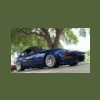
Modern Motorsports Adjustable LCAs
74_5.0L_Z replied to RebekahsZ's topic in Brakes, Wheels, Suspension and Chassis
It sounds like she is trying to fit the largest tire under the rear of her car without getting carried away with negative camber. Too much negative camber hurts forward traction. I went through the same issues trying to fit 275/35-15 Hoosiers under my SubtleZ rear fenders. In the end, I had to use 15x10 wheels with a 5.5 inch backspace, shorten my control arms to 14.25 inches, and max out my camber plates (toward positive camber). One issue that you have to watch when trying to shorten your lower control arms is bottoming of the CV axles. -

Lug nuts from Ebay hell.
74_5.0L_Z replied to MidnightRider's topic in Brakes, Wheels, Suspension and Chassis
I have aluminum lugs on my car. They are wonderful. They are extremely light and just as strong as steel (they are made of 7075T6). They have been torqued hundreds of times to 75 ft-lbs without any signs of degradation. Plus, they look great and the anodizing has been very durable. These are the lugs that I use: http://www.amazon.com/gp/product/images/B002801YBE/ref=dp_otherviews_z_1?ie=UTF8&s=automotive&img=1 I have replaced the stock studs with longer ARP M12x1.5 studs. The factory studs use the 1.25 pitch. Make sure you order the correct thread pitch for the studs you have installed in your car. -

4.6L Ford DOHC modular motor in my 240z
74_5.0L_Z replied to notheredave's topic in Ford V8Z Tech Board
Glad to be of assistance The additional U-Joint that I used was this 5/8 weld in piece from Sweet Manufacturing: http://pitstopusa.com/i-5056027-sweet-steering-universal-joint-5-8-smooth-x-5-8-smooth.html I can't wait to see the 4.6L on the road. -
They are Spin Werkes series 82 wheels. They are very similar to the Diamond wheels, but they are constructed of aluminum. My wheels are 15x10 and weigh 14.9 lbs each. I highly recommend Spin Werkes. The wheels are lightweight, and you can specify the width, backspace, bolt pattern, and center bore diameter. My wheels cost approximately $250 each. These are probably the most affordable custom aluminum wheels available. Here is a link to the company's Facebook page: http://www.facebook.com/pages/Spin-Werkes-Aluminum-Racing-Wheels/100456613370000
-
Jon, That is the petcock on my radiator catch can. It does hang down a bit, but it has never hit anything. I probably should raise it a bit, but I may never get around to it until I break it off
-
I recently redid the rear portion of my exhaust to have the mufflers (Borla Pro XS) follow the line of the body.
-
I applaud Mongo's efforts on this rear suspension set-up. The entire thing is over-built, but that was intentional on his part because this was a prototype. If you notice, he has built adjustability into every part of it so that the optimal design could be attained through trial and error. I would love to build a similar set-up based on his design that has been optimized for weight. There are things that I would like to know: What does the camber curve look like (how much gain per inch of bump and inch of droop)? Where is the roll center? If you don't know these, then perhaps I can help you determine them based on dimensions.
-
I am sorry to hear about your car, but I am glad that your son was not hurt. I really like your rear suspension, but damn those are some huge heim joints at the top of the strut housing
-
The CV halfshaft angles are not important as long as they are kept in a reasonable range (<10 degrees). If it were me then I would lower the differential as far as possible with respect to ground clearance. I just lowered the mounting of my differential by one inch relative to the body for three reasons: First, I wanted to minimize my drive shaft angle. The driveshaft was running uphill from the transmission to the pinion, but now it is level in the horizontal plane. Second, I wanted the halfshafts to be at their minimum length at full droop. The reason for this is that I use 300ZX turbo halfshafts with the Modern Motorsports adapters. These axles were close bottoming during suspension motion when the axles were straight. By lowering the differential, the axles are always angled up toward the wheels even at full droop. I only have 2 inches of droop travel in my suspension. Third, the R200 is heavy (and the R230 is really heavy) and should be mounted as low as possible to keep the CG as low as possible.
-
I am interested in the Carbon Fiber BRE rear spoiler. How tall is it? Is the carbon fiber version a straight bolt on (No modification/sanding/painting of the spoiler required)? Can I order it with additional mounting points on the bottom (4 instead of two)? Can I order it with mount fasteners across the back face so that I can extend the height with a sheet of lexan? Can you post some larger pictures of this spoiler installed so that I can examine the quality a little more closely? I am trying to add a good looking basic spoiler that can be adjusted to increase/decrease rear downforce. Thanks, Dan McGrath
-
That what I am using. I also am using the Gorilla 7075 Aluminum Lug Nuts. http://www.summitracing.com/parts/GOR-44037BK/ To install the studs, I removed the front wheel hubs and rear axles so that I could work on the bench. I used a 280ZX rear brake rotor as a fixture to hold the hubs/axles while I installed the studs. To do this, I placed the rotor on the work bench with the wheel mounting flange face up. I then placed the axle /hub face down through the rotor. The rotor is a close tolerance fit to the hub center and the studs and was used to keep the studs square with the face of the rotor. I then fed each of the four studs through the back of the hub/axle, through the rotor, and installed a stack of washers and hardened M12x1.5 nuts (not the lug nuts!) on the opposite side of the rotor face. After all the nuts were installed, I drew the studs through the flange by tightening the nuts. The torque required to draw the studs through the flange can be considerable. Don't exceed 75 ft-pounds during the process or you can damage your new studs. If you reach max torque before the stud is completely installed, then flip the assembly over and tap the back of the studs with a hammer to make sure that they are fully seated. Finally, torque the nuts to 75 ft-lbs, and then remove the nuts, washers and rotor. Repeat for each hub/axle. Grease bearings and reinstall hubs/axles.
-
I drove a stock 260Z for seven years. It had the four speed transmission and 3.70 rear gear ratio. I think that I only got 14-15 miles per gallon. After I graduated in college in 1998, I built a 260Z with a 5.0L and T5 transmission and same 3.70 rear gear. I drove it as a street car for about five years and would get about 20-25 mpg on the highway (when I could keep my foot off of the floor). The key to making a drivable V8 datsun is installing an overdrive transmission. Without an overdrive the RPMs at highway speed are too high. For example, with a 245/45/16 rear tire 24.5" tall, a 3.545 rear and no overdrive, your RPMS will be 3400 at 70 mph. With the T5 transmission, 5th gear is 0.67 to 1 and your rpms with the same tire and same rear gear will be 2280 rpm at 70 mph. Which set-up do you think will get better gas milage, be more fun to drive on the highway, and have less wear on the engine. My current set-up has a 3.36 rear gear, but I have gone to a shorter tire (23.0 tall 275/35-15). I have also upgraded to a GForce T5 which has better gear ratios for 1st and second gear. The overdrive in the Gforce T5 is a ridiculous 0.59 to 1. Even with my short tire 70 mph is 2100 rpms in fifth gear.
-
I really appreciate all the hard work and technical info you've shared [particularly in the Suspension Tech / Motion Ratio / Unsprung Weight thread(s)]. Really helpful to a guy like me that appreciates "geeky" discussions but doesn't have any experience / practical knowledge beyond my own lessons learned.
Thanks again!

-
For me the droop limiter was more for keeping the springs seated when the car is jacked up or when I lift a front wheel in a turn. My limiters are set so that the springs are "almost" loose at full droop. Without the limiters, the struts will allow the front wheel to droop more than an inch below the point where the springs are in their seats. I've been wanting to come back and do some more with this topic, but I have been busy lately. I am working on my Masters Degree in Mechanical engineering and that eats up all of my time. I have only run the car at two events this year, so it is mostly collecting dust in the garage. I plan to take the summer off from school, so I plan to do some serious playing with the car. I have a brand new set of Hoosier 275-35-15 tires that need to be used and abused. It would be interesting to play with the droop thing some more, and I am also contemplating replacing the droop limiters with helper springs to allow the tire to stay on the pavement without changing my ride frequency. I'll update this later in the summer. Dan
-
My Ford powered 260Z has been driving for better than 10 years now. For most of that time, the engine was a stockish 5.0L with Edelbrock heads. The car evolved from a street car, to an occasional drag racer (12.2 @ 113 mph), to a full time autocrosser. During the first 10 years, the car was equipped with a World Class T5 transmission (that came from a junkyard), a king cobra clutch, and a Tilton hydraulic release bearing. The transmission lasted 10 years. Two years ago, I upgraded my engine to a 331 stroker making 365hp/375tq at the wheels on a SuperFlo dyno. The old transmission finally died with a bang when I took all of the teeth off second gear powering out of a corner. Post-mortem on the transmission also revealed that the input shaft was twisted about five degrees. I had found the limit of the stock T5. I have since upgraded to a G-Force T5, and I am extremely happy with the results. The new transmission weighs nearly the same as the stock T5 (~75 pounds), has better gear ratios, and can handle 500+ horsepower. I was also able to reuse my Tilton HTOB, and my King Cobra pressure plate. I did however have to purchase a new disc because the G-Force T5 uses a bigger input shaft with 26 splines rather than 10. Because I primarily autocross my car, weight is everything. The Tremek TKO weighs about 140 pounds, and the T5 weighs ~75. So, for me the decision was a no-brainer. If it were me, I would go with the G-Force T5 unless I were to combine drag racing, slicks, and more than 500 hp. Dan
-
For me the solution was to add additional U-joint to the steering shaft. This also requires an additional constraint to control the motion of the shaft. Here are some old pictures of my car that show the extra universal joint and the rod end used to control the motion. Here is a picture from below (Again a very old picture). In this picture I have gone to a front plate mid-plate motor mount system so the stock motor mounts are out of the way and there is a lot of room under the engine. If look back at some of my old posts (circa 2001-2003), I have discussed the important considerations for adding an additional u-joint to the steering shaft. Remember, phasing is important. Also, looking at your engine position, it looks like you could move it farther back. The back of my driver's side cylinder head is 1" from the firewall, and my harmonic balancer is directly above the rack (1" above). Can you move the engine toward the passenger side at all. My engine is centered left to right, but if I were to do it again I would mount the engine offset 1 to 1.5 inches to the right. Good luck, Dan
-

First impression of Formula Atlantic slicks
74_5.0L_Z replied to 74_5.0L_Z's topic in Brakes, Wheels, Suspension and Chassis
I looked at the Goodyear radials, and they look like a good option with one minor problem: They cost nearly twice as much as the Bias-Ply. I can't afford $400.00 per tire. -

First impression of Formula Atlantic slicks
74_5.0L_Z replied to 74_5.0L_Z's topic in Brakes, Wheels, Suspension and Chassis
I'm past the point where I'm trying to make them work. I plan to buy some NEW tires. I have 15 x 10 wheels and want the best tires I can get in terms of traction and longevity. The ones that I have found that will fit are the following: Hoosier 275/35-15 A6 Goodyear 23.0x10.5-15 Bias Ply slick (250 compound) I have never run the Goodyears and was hoping to get impressions from someone that had. Cameron, have you found a favorite tire? I think you tried the Avon slicks. Did they work and last better than the Hoosiers? -

First impression of Formula Atlantic slicks
74_5.0L_Z replied to 74_5.0L_Z's topic in Brakes, Wheels, Suspension and Chassis
Ok, I've gone through several sets of the used Hoosier 23x9.5-15 FA slicks. I typically get 3 to 4 events before they die. I get them cheap, but not that cheap. I am tired of buying used tires, so I plan to order some new tires this week. Here are the tires I am considering: Hoosier 275/35-15 A6 Goodyear 23.0x10.5-15 Bias Ply slick (250 compound) The initial cost for each is the same. Does anyone have any experience with the Goodyear? How is the longevity? I would really like a set of tires that wil last for a whole season. If anyone else has a good suggestion for a tire that fits the 15x10 wheels, I'm all ears. -

Lug nuts for Rota wheels-quality ones
74_5.0L_Z replied to madkaw's topic in Brakes, Wheels, Suspension and Chassis
I switched to all ARP M12 x 1.5 wheel studs and use the Gorilla open end lug nuts. The lug nuts are 7075 aluminum and are incredibly light. The black anodized finish is very nice too.

